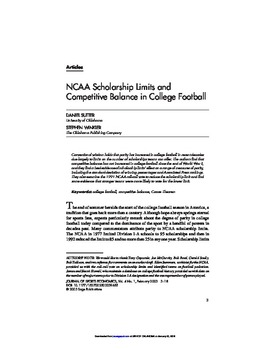| dc.contributor.author | Daniel Sutter | |
| dc.contributor.author | Stephen Winkler | |
| dc.date.accessioned | 2016-01-14T19:53:42Z | |
| dc.date.accessioned | 2016-03-30T15:32:37Z | |
| dc.date.available | 2016-01-14T19:53:42Z | |
| dc.date.available | 2016-03-30T15:32:37Z | |
| dc.date.issued | 2003-02-01 | |
| dc.identifier.citation | Sutter, D., & Winkler, S. (2003). Ncaa Scholarship Limits and Competitive Balance in College Football. Journal of Sports Economics, 4(1), 3-18. doi: 10.1177/1527002502239655 | en_US |
| dc.identifier.uri | https://hdl.handle.net/11244/25400 | |
| dc.description.abstract | Conventional wisdom holds that parity has increased in college football in recent decades due largely to limits on the number of scholarships teams can offer. The authors find that competitive balance has not increased in college football since the end of World War II, and they find mixed evidence of scholarship limits’ effect on a range of measures of parity, including the standard deviation of winning percentages and Associated Press rankings. They also examine the 1991 NCAA roll-call vote to reduce the scholarship limit and find some evidence that stronger teams were more likely to vote for the lower limit. | en_US |
| dc.language.iso | en_US | en_US |
| dc.publisher | Journal of Sports Economics | |
| dc.subject | college football | en_US |
| dc.subject | competitive balance | en_US |
| dc.subject | Coase Theorem | en_US |
| dc.title | Ncaa Scholarship Limits and Competitive Balance in College Football | en_US |
| dc.type | Research Article | en_US |
| dc.description.peerreview | Yes | en_US |
| dc.description.peerreviewnotes | https://us.sagepub.com/en-us/nam/manuscript-submission-guidelines | en_US |
| dc.identifier.doi | 10.1177/1527002502239655 | en_US |
| dc.rights.requestable | false | en_US |
